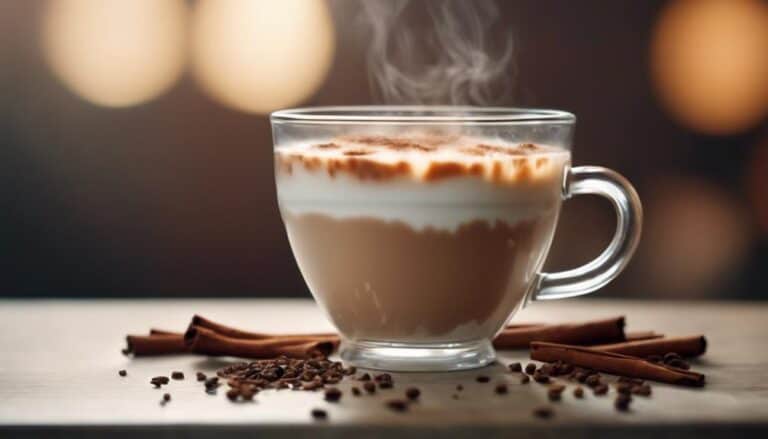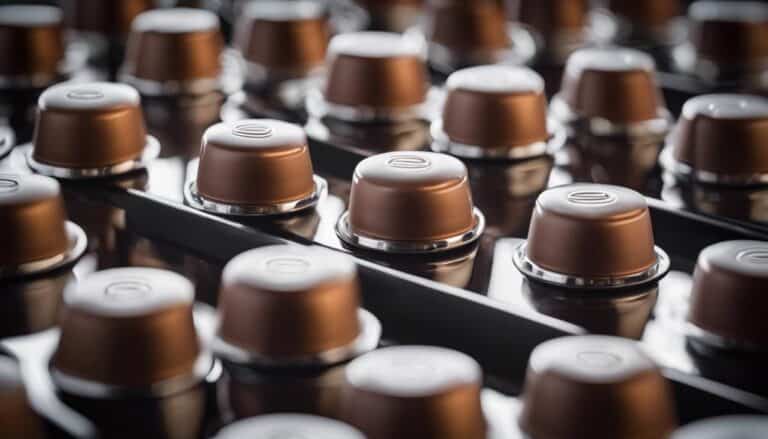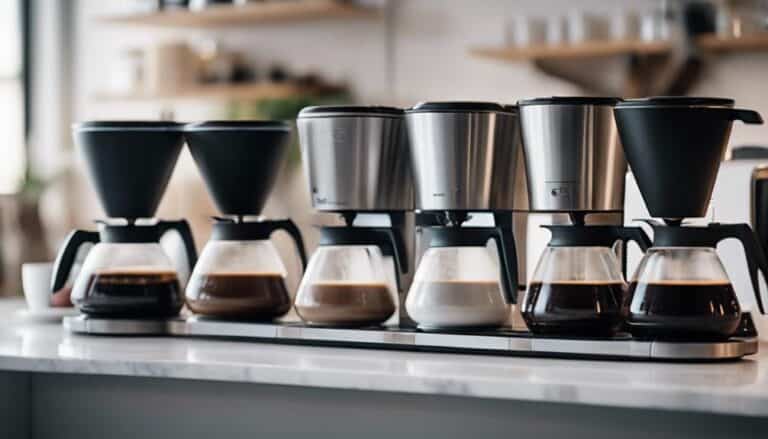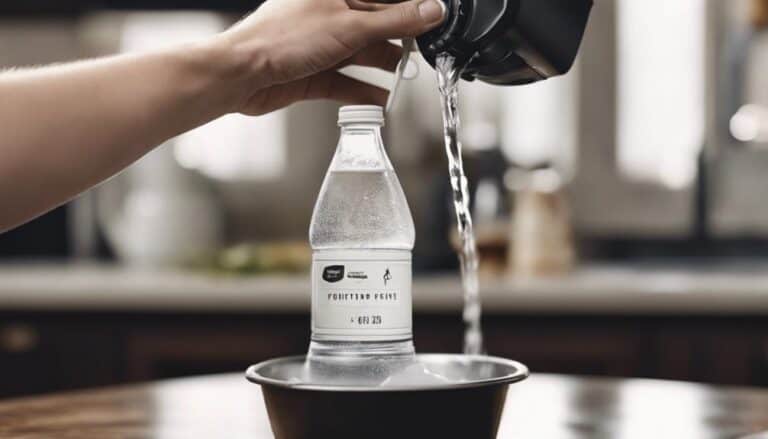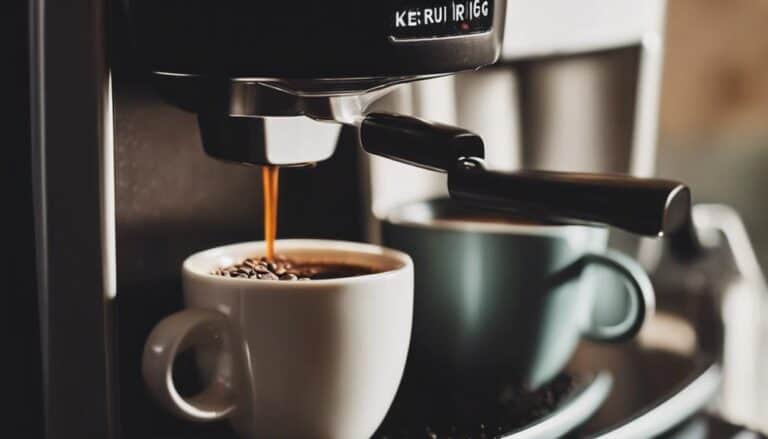Cappuccino and Latte: 10 Key Differences

As a coffee enthusiast, I've often found myself contemplating the subtle yet significant disparities between cappuccinos and lattes. The way these two classics diverge in their milk-to-espresso ratio, foam texture, and overall flavor profiles is truly intriguing. Each sip offers a distinct experience that caters to different palates and preferences. Exploring these ten key differences between cappuccinos and lattes sheds light on the intricate art and science behind these beloved coffee concoctions.
Milk-to-Espresso Ratio
When crafting the perfect cappuccino or latte, the milk-to-espresso ratio plays a pivotal role in defining the flavor and texture of each espresso-based drink. The milk-to-espresso ratio determines the intensity of the coffee taste and the overall creaminess of the beverage.
In a classic cappuccino, the 1:1:1 ratio of espresso, steamed milk, and milk foam creates a harmonious blend where the bold espresso flavor shines through, balanced by the velvety texture of the steamed milk and the light frothiness of the foam. This balanced ratio results in a rich and robust flavor profile that appeals to those seeking a more intense coffee experience.
On the other hand, lattes with their higher milk-to-espresso ratio offer a smoother and creamier taste. The 2:1 or 3:1 ratio of steamed milk to espresso produces a milder coffee flavor, making lattes a popular choice for those who prefer a more subtle coffee taste with a luxurious mouthfeel.
Adjusting the milk-to-espresso ratio allows baristas and coffee enthusiasts the freedom to customize their drinks according to their preferences, creating a diverse range of flavors and textures to suit every palate.
Foam Texture
With a focus on foam texture, the distinction between cappuccinos and lattes becomes evident in the varying levels of frothiness that characterize each espresso-based drink. Cappuccinos are known for their thick and velvety foam layer on top, achieved by steaming milk to introduce air bubbles, resulting in a luxurious and creamy texture. On the other hand, lattes feature a thinner layer of milk foam, creating a smoother and milder texture compared to cappuccinos. The foam in cappuccinos not only adds to the visual appeal but also enhances the overall coffee experience with its rich and creamy mouthfeel. Lattes, focusing more on the steamed milk, provide a balanced and milky flavor profile with a subtle frothy layer on top. The differing foam textures in these drinks cater to various preferences, offering coffee enthusiasts a choice between a creamier, foam-focused cappuccino or a smoother, milk-forward latte.
| Cappuccino | Latte |
|---|---|
| Thick foam layer | Thin foam layer |
| Creamy texture | Smooth texture |
| Rich mouthfeel | Mild mouthfeel |
| Luxurious experience | Balanced flavor |
| Airy and frothy | Subtle froth |
Coffee Flavor Intensity

When savoring a cappuccino, the intense coffee flavor immediately captivates my senses with its rich and robust notes. The aroma of the espresso, combined with the velvety milk foam, creates a harmonious balance that excites my taste buds.
In contrast, lattes offer a smoother, milder taste that can be further enhanced with a variety of sweet and flavorful syrups.
Flavor Richness Comparison
In comparing the flavor richness of cappuccinos and lattes, one immediately notices the distinct intensity of the coffee flavor in a cappuccino attributed to its lower milk content. The balance achieved in a cappuccino, with its espresso base and velvety steamed milk, creates a bold and robust coffee experience that truly shines through. This richness allows the complex flavors of the espresso to take center stage, giving each sip a deep, satisfying taste that lingers on the palate.
On the other hand, lattes, with their higher milk content, offer a creamier texture but sometimes dilute the coffee flavor, resulting in a smoother, sweeter drink. The choice between these two beverages ultimately comes down to the preference for either a more intense coffee kick or a milder, milkier indulgence.
Aroma Strength Variation
The aromatic journey from a cappuccino to a latte reveals a distinct shift in coffee flavor intensity, showcasing the artful balance between espresso and milk ratios. Cappuccinos, with their higher espresso to milk ratio, offer a stronger aroma and bolder coffee flavor, appealing to those who crave a robust coffee presence. On the other hand, lattes, with more steamed milk, provide a milder aroma and gentler coffee flavor intensity, catering to a preference for a smoother, creamier experience. The variation in aroma strength between these two classic drinks is a demonstration of the diverse preferences in coffee flavor intensity. Let's explore this contrast further in the table below:
| Aspect | Cappuccino | Latte |
|---|---|---|
| Espresso to Milk | Higher ratio | More steamed milk |
| Aroma Strength | Robust and bold | Smoother and creamier |
| Intensity | Strong | Gentle |
Taste Profile Differences
Exploring the intricate world of coffee flavors, one can discern a significant divergence in taste profiles between a cappuccino and a latte, particularly in their distinct levels of coffee flavor intensity. Cappuccinos boast a bold and robust coffee flavor, achieved through a higher ratio of espresso to milk. This appeals to those who savor a stronger coffee taste.
On the other hand, lattes offer a milder and creamier experience, with the milk component taking precedence over the coffee flavor. The balance in cappuccinos leans towards the coffee's bitterness, while lattes focus on the sweetness and creaminess of steamed milk.
Whether you crave the pronounced espresso kick in a cappuccino or the comforting milky smoothness of a latte, these distinct taste profiles cater to varied coffee preferences.
Milkiness Level
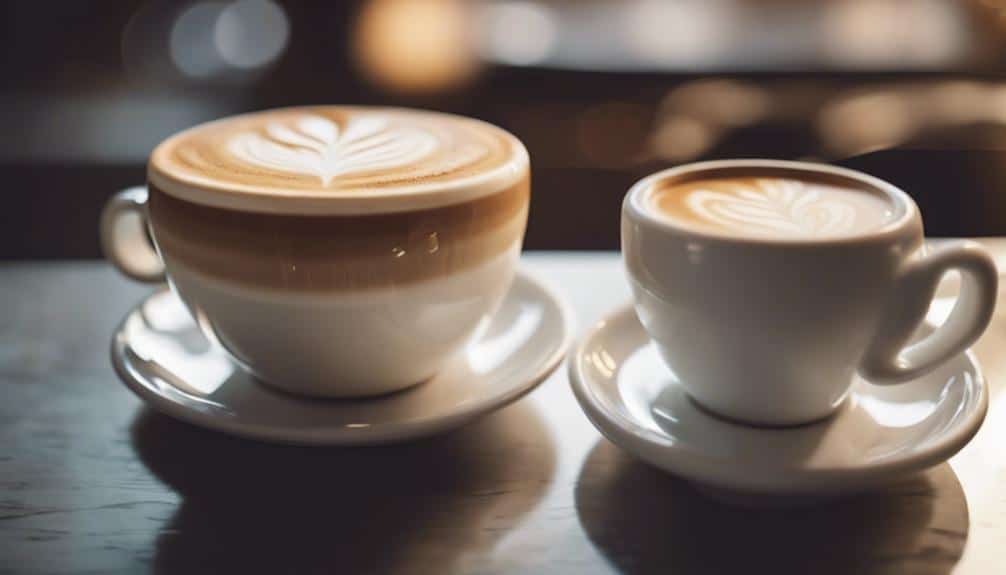
Milkiness plays an essential role in distinguishing between cappuccinos and lattes, defining their unique textures and flavors. When it comes to the milkiness level, cappuccinos and lattes showcase distinct characteristics that appeal to different preferences:
- Lattes have a higher milkiness level due to a larger ratio of steamed milk to espresso, resulting in a smoother and creamier texture.
- Cappuccinos maintain a lower milkiness level with equal parts espresso, hot milk, and milk foam, providing a bolder coffee flavor.
The milkiness level in lattes contributes to a velvety mouthfeel, making it a comforting choice for those who enjoy a more mellow coffee experience.
Cappuccinos, with less steamed milk and more foam, offer a stronger espresso kick, perfect for those seeking a robust coffee flavor.
Understanding the difference in milkiness level between cappuccinos and lattes is important as it impacts the overall taste and enjoyment of these beloved espresso-based beverages.
Layering Technique
Let's talk layering techniques!
The foam thickness, milk to espresso ratio, and visual appeal play vital roles in distinguishing cappuccinos from lattes. Understanding these aspects is key to appreciating the nuanced differences between these beloved espresso-based beverages.
The precision in layering not only impacts the taste but also contributes to the overall experience of savoring a perfectly crafted cappuccino or latte.
Foam Thickness Comparison
Comparing the foam thickness between cappuccinos and lattes reveals an essential aspect of their distinct layering techniques.
- Cappuccinos: Thicker foam layer scooped from steamed milk creates a dense, prominent texture.
- Lattes: Thinner foam layer achieved by pouring frothed milk evenly for a smoother, creamier texture.
The foam in cappuccinos is dense, providing a visually appealing contrast.
Lattes have a lighter foam layer, contributing to a velvety mouthfeel.
Foam thickness impacts both the texture and presentation of these beloved coffee drinks, making each sip a unique experience.
Milk and Espresso Ratio
In crafting the perfect cappuccino or latte, the milk and espresso ratio plays a vital role in determining the drink's overall flavor profile and texture. Cappuccinos boast equal parts espresso, hot milk, and milk foam, creating a harmonious blend of flavors in distinct layers. On the other hand, lattes feature a higher proportion of steamed milk to espresso, resulting in a creamier and milkier consistency. The layering technique is essential, as cappuccinos evenly distribute espresso, steamed milk, and frothed milk, while lattes employ a method where espresso is poured first, followed by steamed milk and a delicate froth layer. This precise balance between espresso and milk, expertly layered, is what sets these two beloved drinks apart.
| Espresso and Milk Ratio | Steamed Milk | Frothed Milk |
|---|---|---|
| Cappuccino | Equal parts | Layered |
| Latte | Higher ratio | Thin layer |
Visual Appeal Differences
Moving on from the meticulous milk and espresso ratio discussion, the visual allure of cappuccinos and lattes is intricately tied to their distinct layering techniques. When it comes to the visual appeal differences:
- Cappuccinos boast structured layers of espresso, steamed milk, and frothed milk.
- Lattes showcase a blended appearance with espresso at the bottom, steamed milk in the middle, and a layer of microfoam on top.
- The structured layers in cappuccinos create a visually appealing separation of ingredients.
- Lattes focus on a harmonious integration of espresso and milk, with a subtle foam layer for added texture.
- While cappuccinos emphasize clear distinctions, lattes offer a seamless and creamy visual experience.
Origin Stories
With origins deeply rooted in Italy and America, the intriguing stories behind the cappuccino and latte illuminate the rich history and cultural influences shaping these beloved coffee beverages. The cappuccino, originating in Italy, was traditionally a breakfast drink named after the Capuchin friars due to the resemblance of its color to their brown habits. On the other hand, lattes have American origins and gained popularity in the 1980s, with the name deriving from the Italian word for milk, emphasizing its key ingredient. Italy's deep-rooted coffee culture influenced the development of the cappuccino, while America's evolving coffee scene shaped the latte as it is understood today.
| Origin | Country | Key Ingredient |
|---|---|---|
| Cappuccino | Italy | Milk |
| Latte | America | Milk |
Foam Thickness

The alluring difference between cappuccinos and lattes comes down to the foam thickness, a defining feature that enhances both the texture and overall experience of these beloved coffee beverages. When it comes to foam thickness:
- Cappuccinos boast a thicker foam layer, providing a more pronounced texture and visual appeal.
- The foam in cappuccinos is denser and velvety, adding a luxurious feel to each sip.
- On the other hand, lattes feature a thinner foam, offering a smoother drinking experience.
- The denser foam in cappuccinos helps retain heat and preserve the coffee's aroma, elevating the overall enjoyment.
- Lattes, with their light foam layer, create a subtle texture that allows the espresso and milk flavors to blend harmoniously, catering to those who prefer a milder foam presence.
Foam thickness plays an important role in distinguishing between cappuccinos and lattes, shaping not only the taste but also the visual and tactile aspects of these delightful coffee concoctions.
Serving Size
Discussing the serving sizes of cappuccinos and lattes reveals insights into the traditional presentation styles and the impact on flavor profiles.
Cappuccinos, served in smaller cups of about 150-180 ml, follow the Italian way of enjoying a well-balanced blend of espresso, steamed milk, and velvety microfoam. This size allows the flavors of the coffee to shine through without being overshadowed by excessive milk.
On the other hand, lattes come in larger 240 ml cups, providing ample space for the heightened milk content and the potential for beautiful latte art. The generous size of lattes accommodates customization with various syrups or flavors while still delivering a creamy and smooth texture due to the use of a milk frother.
The contrast in serving sizes contributes to distinct drinking experiences; cappuccinos offer a bolder coffee taste, while lattes provide a creamier and more mellow flavor profile, making each sip a delightful exploration of milk versus espresso shots.
Popular Variations
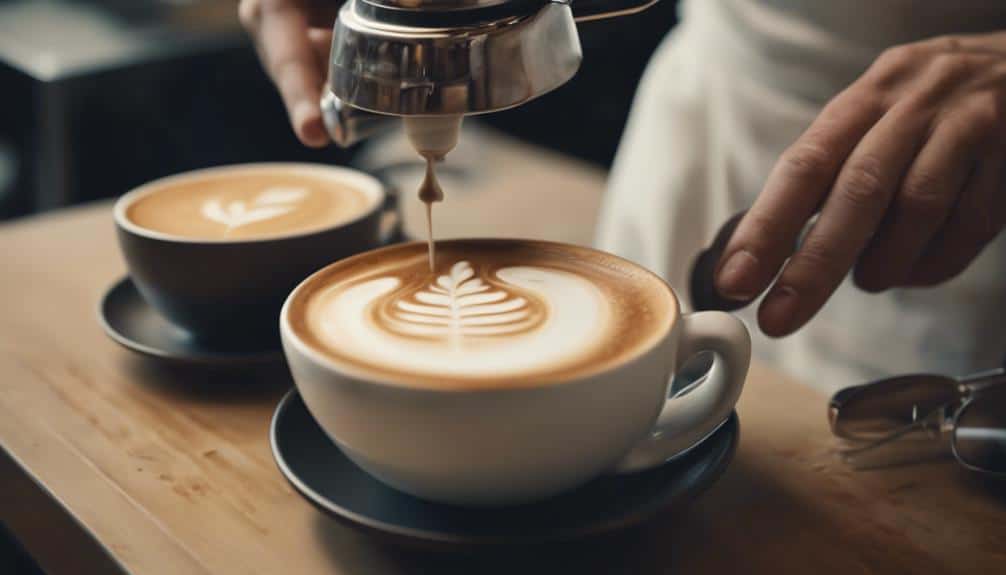
Exploring a world of flavor possibilities, lattes offer a versatile canvas for indulging in a delightful array of popular variations. Here are some exciting options to mull over:
- Vanilla, Hazelnut, and Caramel Flavors: These classic additions bring a touch of sweetness and warmth to your latte, elevating its taste profile.
- Matcha, Mate, or Tea: For a unique twist, try substituting espresso with matcha, mate, or tea to create a distinct and invigorating beverage.
- Chai Lattes: Made with black tea and a blend of spices, chai lattes offer a cozy, aromatic experience with a hint of exotic flavors.
- Mocha: Indulge in the rich combination of chocolate and espresso for a decadent treat that satisfies both your coffee and sweet cravings.
- Pumpkin Spice: Perfect for the autumn season, pumpkin spice lattes infuse your drink with a comforting blend of spices, evoking feelings of warmth and nostalgia.
Lattes truly cater to diverse tastes, allowing you to customize your drink with a variety of flavors to suit your mood and preferences.
Art of Espresso-Milk Balance
When perfecting the art of espresso-milk balance in cappuccinos and lattes, frothing milk techniques play a pivotal role in achieving the desired texture and consistency.
The espresso to milk ratio is carefully calibrated to create distinct layers of flavor and mouthfeel in each sip, highlighting the nuances of the coffee and milk components.
Understanding these nuances allows baristas to craft beverages that cater to a range of preferences, from bold and robust to creamy and smooth.
Frothed Milk Techniques
Mastering the art of frothing milk is an essential skill for crafting the perfect cappuccino or latte, ensuring the ideal balance of espresso and milk froth in every sip. When it comes to frothed milk techniques, here are some key points to take into account:
- Cappuccinos boast a thick layer of foam for that velvety texture.
- Lattes showcase a thin layer of microfoam, providing a smoother mouthfeel.
- Balancing espresso and frothed milk in cappuccinos requires skill for the desired foam consistency.
- Lattes focus on creating microfoam to enhance the creamy texture and blend seamlessly with espresso.
- Baristas must master frothing techniques to achieve the perfect balance of espresso and milk froth.
Espresso to Milk Ratio
Achieving the perfect balance between espresso and milk is an art form that elevates the essence of a cappuccino or latte to a harmonious symphony of flavors and textures.
In cappuccinos, the equal parts of espresso, steamed milk, and milk foam create a well-rounded and bold flavor profile. The structured layers of espresso, milk, and foam in a cappuccino highlight the richness of the coffee, providing a delightful contrast in every sip.
On the other hand, lattes boast a higher ratio of steamed milk to espresso, resulting in a creamier and smoother texture that emphasizes the milk's sweetness. This difference in espresso to milk ratio between cappuccinos and lattes allows for a diverse range of preferences and customization options in the world of coffee.
Conclusion
To sum up, the differences between cappuccinos and lattes are what make them so special and appealing to coffee lovers everywhere. From the bold and intense flavor of a cappuccino to the creamy and smooth taste of a latte, there's something for everyone to enjoy.
The unique foam textures, milk-to-espresso ratios, and serving sizes add to the charm of these beloved coffee beverages. So next time you're craving a delicious coffee experience, don't forget to choose between a cappuccino and a latte for a truly memorable treat.
